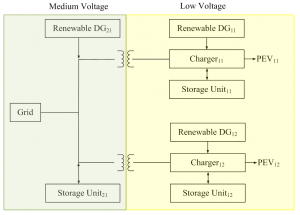Methodology for the Optimal Design of PEV Charging Systems with Multiple Chargers and Distributed Resources
- Category: Energy
- Tags: david perreault, samantha gunter

Figure 1: A PEV public charging system configuration with two distribution voltage levels. This configuration has two charging locations and three possible locations for the renewable DG and storage units.
Increased penetration of plug-in electric vehicles (PEVs) will necessitate deployment of a large number of PEV chargers[1],[2], but chargers can incur substantial operating costs and strain the distribution grid[3],[4]. Pairing these PEV chargers with renewable distributed generation (DG) and energy storage can alleviate negative impacts on the distribution grid and help meet renewable portfolio goals. The optimal design of such integrated charging systems depends on a number of factors, including their geographic location and the expected charging profiles. To address this design challenge, we developed an optimization methodology with respect to system lifecycle cost for designing integrated PEV charging systems with multiple PEV chargers and distributed resources.
This methodology is used to study optimal system designs for public charging at a retail business and on a university campus. In both cases, we consider a configuration with one grid connection point, two charging locations, and three possible locations for renewable DG and storage as shown in Figure 1. In cases where the addition of PEV charging can cause a demand charge to be incurred, it is shown that if charging is coincident in time with DG power production, then the optimal design is one that uses solar DG and the minimum amount of lead-acid storage needed to limit the amount of power drawn from the grid to less than the level that triggers a demand charge. However, if charging is not completely coincident with DG power production, the optimal design decision is more complicated and depends on the level of existing load. When non-negligible distribution system losses occur between charger locations, such as due to transformers and long cables, it is shown that the size and location of the DG and storage unit depend on, among other things, the charging profile of the different chargers and the distribution efficiency.
- Supplemental Tables to the Annual Energy Outlook 2012, US Energy Information Administration (EIA), Department of Energy, Washington, DC, June 2012. [↩]
- D. Mead, “Top Five Electric Vehicle Initiatives of the Year,” Greentech Media, Dec. 8, 2011. [↩]
- D. Karner, Clean Cities Webinar [Online]. Available at: http://www.theevproject.com/cms-assets/documents/70198-833686.clean-cities-webinar.pdf, June 25, 2012. [↩]
- J. G. Kassakian, R. Schmalensee, T. D. Heidel, K. K. Afridi, D. J. Perreault, S. J. Gunter, et al., The Future of the Electric Grid, Cambridge: Massachusetts Institute of Technology, Dec. 2011. [↩]